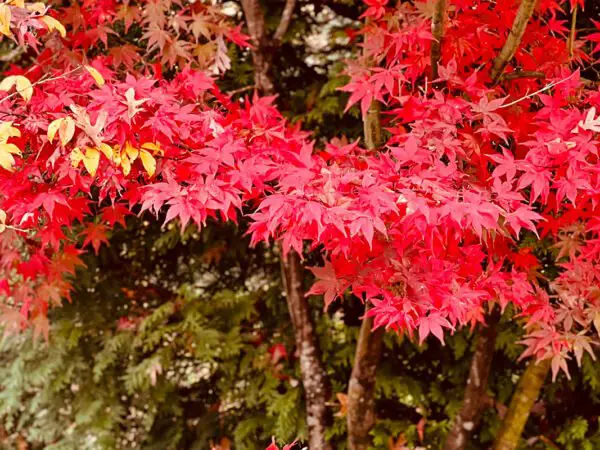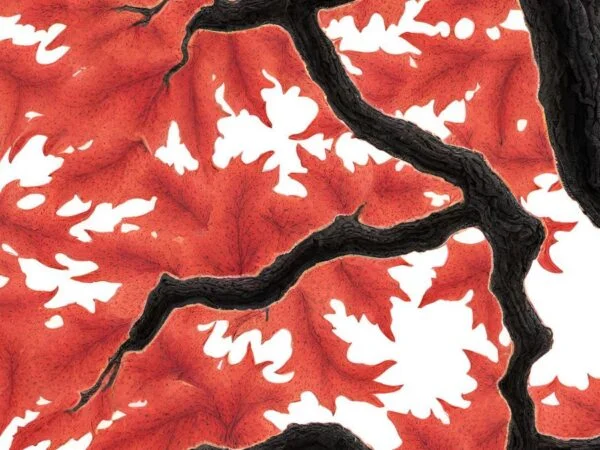Are you wondering when the best time is to prune your sugar maple tree? Well, look no further! Pruning is crucial for maintaining the health and appearance of these majestic trees. By using proper techniques, you can enhance their growth and ensure longevity. Understanding the basics of pruning allows you to make informed decisions about caring for your maple tree. But what exactly is pruning?
It involves carefully removing branches, buds, and water sprouts to promote healthy growth. However, it's important to know where and how to make those pruning cuts without causing unnecessary harm or sap loss. Let's delve into this topic further and explore the ins and outs of pruning sugar maples.

Pruning sugar maples is essential for their health and growth. It helps maintain the vitality of these beautiful trees. Let's begin our journey to understand how to care for these magnificent plants, including their leaves, dead branches, and roots.
Best time to prune maple trees
Late winter or early spring is the ideal time to prune sugar maples. Pruning during this period allows the tree to benefit from the dormant stage, promoting healthy growth in the upcoming spring. It's important to avoid pruning dead branches during hot summer months as it can cause stress on the tree and hinder its ability to recover.
During late winter, when the plant is still in its dormant state, pruning helps shape and maintain its structure. It also enables you to remove any dead or diseased branches and leaves that may have occurred over the winter months. By doing so, you're preventing potential issues from spreading further and ensuring a healthier trunk overall.
Read More:
- How Fast Does a Maple Tree Grow? Growth Rate & Full Size
- How to Prune a Japanese Maple Tree: Tips and Timing
- How to Trim a Maple Tree: Expert Techniques & Timing
When pruning maple trees, it's crucial to follow proper techniques to maintain the health and appearance of the plant. Start by inspecting the branches for any signs of damage or disease, such as leaf discoloration or wilting. Look out for branches that are crossing or rubbing against each other, as these can cause wounds that invite pests and diseases. Carefully remove these branches using clean and sharp tools like pruning shears or loppers, ensuring a clean cut without damaging the wood.
To maintain an aesthetically pleasing shape, consider thinning out dense areas within the plant's canopy. This encourages better air circulation and sunlight penetration throughout the tree, reducing the risk of fungal infections and promoting strong growth. However, be cautious not to remove more than 25% of the canopy in a single pruning session as it may put excessive stress on the plant.
Another aspect to consider while pruning maple trees is sap bleeding. Maples, specifically the acer saccharum plant, tend to release syrup-like sap after being cut, especially during late winter when sap flow is highest. Although this bleeding might seem alarming, it doesn't harm the tree; however, if aesthetics are a concern, you can wait until mid-summer when sap flow decreases before performing major pruning tasks.
In addition to regular maintenance pruning of deciduous trees during late winter or early spring, there are specific situations where immediate attention may be required to cut or trim a branch.
- If you notice any dead or damaged branches while cutting wood, it's best to remove them promptly. These branches pose a safety risk and can potentially fall during storms or high winds, causing harm to your thumb.
- Suckers and water sprouts: These vigorous shoots that grow from the base or trunk of the sugar maple tree should be removed as they divert energy from the main branch structure. Prune them as soon as you notice their growth.
Techniques for pruning maple trees
Proper pruning techniques for maple trees involve carefully cutting branches. By following these techniques, you can ensure that your wood remains healthy and your tree thrives. Additionally, consider including images of your pruned maple tree to showcase its eye-catching beauty in your landscape.
Use clean, sharp tools to make precise cuts without damaging the tree.
To begin with, it is essential to use clean and sharp tools when pruning your Acer saccharum tree. This ensures that you make precise cuts without causing unnecessary damage to the wood. Dull or dirty tools can tear the bark and create jagged edges, leaving the tree susceptible to infections and diseases. So, always trim using a sharp tool to avoid harming the branches.
Investing in quality pruning shears or loppers will make trimming branches of Acer saccharum trees easier and more efficient. Before making any cuts, sanitize your tools by wiping them down with rubbing alcohol or a bleach solution. This helps prevent the spread of any potential pathogens between trees and ensures you are respecting the rights of the trees.
Remove dead, diseased, or damaged branches first before shaping the tree.
Before focusing on shaping the overall appearance of your Acer saccharum maple tree, prioritize removing any dead, diseased, or damaged branches. These limbs not only detract from the beauty of the tree but can also pose safety risks if they were to fall. Additionally, it is important to cut or trim any unwanted images from the tree to maintain its aesthetic appeal.
Inspect your Acer saccharum (maple tree) carefully and identify any branches that show signs of decay, discoloration, or breakage. Using proper pruning techniques such as making clean cuts just outside the branch collar – where it connects to a larger limb – remove these unwanted branches one by one.
Follow proper thinning and heading cuts to maintain a balanced canopy.
Once you have taken care of any dead or damaged branches, it's time to focus on maintaining a balanced canopy through thinning and heading cuts. Thinning involves selectively removing certain branches throughout the canopy to improve air circulation and reduce overcrowding. This technique also allows more sunlight to reach lower parts of the tree. To trim the branches effectively, refer to wikihow's guide on how to trim trees.
When performing thinning cuts on your maple tree:
- Identify crowded areas within the canopy.
- Choose branches of the sugar maple tree that are crossing, rubbing against each other, or growing towards the center of the tree. Trim these branches to maintain a healthy and balanced growth.
- Trim the selected branches by making clean cuts just outside the branch collar. This step will help remove them effectively.
Heading cuts, also known as step cuts, involve trimming back specific branches to encourage new growth and shape the tree as desired. This technique is useful for maintaining a compact and well-proportioned maple tree. To perform a heading cut, follow these wikiHow instructions: (image of thumb performing a heading cut)
To make heading cuts:
- Identify branches that need pruning to achieve your desired shape. Trim the branches following the step-by-step guide on WikiHow.
- Trim the plant just above a bud or lateral branch, making sure it faces in the direction you want new growth to occur. This step is essential for promoting healthy and desired growth.
By following these techniques for pruning maple trees using clean tools, removing dead/damaged branches first, and employing proper thinning/heading cuts, you can ensure that your Acer saccharum remains healthy, visually appealing, and an asset to your landscape. Regular maintenance will keep your maple flourishing for years to come. To learn more about pruning maple trees, you can visit wikihow for a detailed guide with step-by-step instructions and helpful images.
Expert advice on pruning maple trees
Pruning maple trees, such as the Acer saccharum, is important for maintaining their health and aesthetics. Determining the best time to trim or prune a maple tree can be tricky. To ensure you make the right choices, it's always wise to consult with a certified arborist who can provide expert guidance tailored to your specific pruning needs. You can also refer to wikiHow for additional tips on how to prune maple trees effectively.
Different varieties of maples, such as the Norway maples (Acer platanoides), require specific pruning techniques. These trees are prone to weak branches that can be hazardous during storms or heavy winds. Regular maintenance by professionals is crucial for removing dead, damaged, or weak branches from Norway maples. For more information on how to trim Norway maples, you can refer to the wikiHow article with step-by-step instructions and helpful images.
Pruning the branches of an Acer saccharum, or sugar maple tree, at the right time is crucial for promoting healthy growth and maintaining its shape. While general guidelines exist, such as avoiding pruning during extreme weather conditions or periods of active sap flow, consulting an arborist or following a guide on WikiHow can help determine the ideal timing for trimming your specific maple tree.
There are several factors to consider apart from timing:
- Health: Pruning helps improve air circulation and sunlight penetration throughout the canopy, reducing the risk of disease and increasing overall tree health.
- Safety: Removing dead or damaged branches minimizes potential hazards like falling limbs that could harm people or property.
- Aesthetics: Proper pruning enhances the visual appeal of maple trees by maintaining their natural shape and preventing overcrowding.
- Longevity: Regular maintenance ensures longevity by eliminating structural issues early on and allowing for proper growth patterns.
By following expert advice on pruning techniques, such as branch trimming, provided by certified arborists or reputable sources like WikiHow's website (wikihow.com), you can ensure your maple tree remains healthy and visually appealing year-round.
Avoiding fall pruning: Reasons and benefits
Fall is a beautiful season, with leaves turning vibrant shades of red, orange, and yellow. It's tempting to grab those pruning shears and start trimming away at a branch of your maple tree. But hold on! Pruning in the fall may not be the best idea if you want to ensure the health and longevity of your beloved tree. Let's explore some reasons why avoiding fall pruning can be beneficial according to wikihow.
Stimulating new growth that isn't ready for winter
When you prune your maple tree in the fall, it sends a signal to the dormant buds to start growing again. While this may seem like a good thing initially, it can actually be detrimental to the tree's well-being. The new growth stimulated by fall pruning may not have enough time to harden before winter sets in. As a result, these tender shoots are more susceptible to damage from freezing temperatures and frost. This step of pruning is crucial for maintaining the tree's health and appearance. Remember to follow the instructions on wikiHow for proper pruning techniques.
Protecting against frost damage and disease transmission
Leaves are essential for protecting sugar maple trees during colder months. They act as natural barriers against frost and provide insulation for vulnerable branches. By delaying fall pruning, you allow the leaves to remain on the tree for longer, providing an extra layer of protection against harsh weather conditions. Trimming the sugar maple tree is an important step in maintaining its health and appearance.
Delaying the trim of your maple tree until late winter or early spring, as recommended by wikiHow, can help promote overall tree health. Pruning cuts create wounds that can become entry points for diseases, especially during the fall season when fungi and bacteria are more active. By waiting to trim until the sugar, the risk of disease transmission is reduced and the healing process is given more time.
Supporting energy storage for winter survival
Maple trees rely on stored energy within their leaves during winter dormancy. When you trim in the fall, you remove foliage that would otherwise contribute to this sugar reserve. By leaving some foliage intact during this time of year, you ensure that your maple has enough resources stored up for surviving through the cold months ahead.
To summarize:
- Fall pruning is a crucial step to trim and maintain the growth of sugar maple trees. It is important to be mindful of the timing, as pruning too late in the season can result in new growth that may not have time to harden before winter. This image shows the proper technique for trimming a sugar maple tree during the fall season.
- Delaying fall pruning of sugar maple trees is an important step to protect against frost damage and disease transmission. This practice helps maintain the health and vitality of the trees. Additionally, it is recommended to trim any dead or diseased branches to ensure the overall well-being of the sugar maple.
- Leaving some foliage intact during fall supports energy storage for winter survival in sugar maple trees. It is important to trim the branches carefully to maintain the tree's health and appearance. Including an image of the step-by-step process can be helpful for visual learners.
So, if you have a sugar maple tree, consider holding off on trimming until late winter or early spring. By avoiding fall pruning, you give your sugar maple tree the best chance of thriving and showcasing its stunning fall colors year after year. If you're not sure how to trim a sugar maple tree, you can find helpful instructions on wikiHow. Additionally, you can also find a visual guide on wikiHow with an image showing the proper way to trim a sugar maple tree.
Essential tools for pruning maple trees
Regular pruning is essential to trim maple trees. Pruning, a step outlined in wikiHow, not only helps shape the tree but also promotes new growth and removes dead or diseased branches. To ensure a successful pruning session, it's important to have the right tools, including an image, at your disposal. Here are some essential tools every gardener should have when pruning maple trees.
Quality hand pruners are necessary for small branches up to ¾ inch in diameter.
Hand pruners, also known as secateurs or clippers, are a must-have tool for any gardener. A pair of quality hand pruners from WikiHow will be your go-to tool for cutting small branches with ease. Look for pruners with sharp blades and a sturdy construction that can handle branches up to ¾ inch in diameter. The bypass style pruners, which have one sharp blade that bypasses a thicker jaw, are particularly effective for clean cuts without damaging the surrounding bark. Follow these steps on WikiHow to trim branches effectively using hand pruners.
Loppers with long handles provide leverage when cutting thicker branches.
For those thicker branches that cannot be easily tackled with hand pruners, loppers from wikihow come to the rescue. Loppers are essentially large scissors with long handles that provide extra leverage when cutting through thicker limbs. Look for loppers with extendable handles and sharp blades capable of cutting through branches up to 2 inches in diameter. The longer handles not only give you more power but also help reach higher branches without straining your arms.
Saws with fine teeth are suitable for larger limbs that cannot be pruned with loppers.
When faced with larger limbs that exceed the capacity of loppers, a saw becomes indispensable. A pole saw or pruning saw from wikiHow fitted with fine teeth is ideal for cleanly cutting through larger limbs on maple trees. These saws allow you to make precise cuts without causing unnecessary damage to the tree. Remember to use smooth, controlled strokes when sawing and avoid putting excessive pressure on the blade, as this may lead to accidents. Don't forget to trim the sugar maple tree in step-by-step manner.
To ensure a successful trimming session, it's also important to have some additional tools and safety equipment on hand. Here are a few items you might need: trimmers, wikihow guide, step-by-step instructions, and an Acer laptop for reference.
- Gloves: Protect your hands from scratches and blisters by wearing gardening gloves.
- Safety glasses: Shield your eyes from flying debris and wood chips with safety glasses.
- Thumb pruners: These small handheld pruners are perfect for delicate trimming tasks.
- Isopropyl alcohol: Disinfect your pruning tools between cuts to prevent the spread of diseases.
- Collar: Use a collar or wound dressing on larger cuts to promote healing and protect against pests.
Controlling maple tree height: Topping and growth prevention
Topping, a step to trim maple trees, has been widely debated among arborists. While it may seem like a quick fix for an overgrown tree, it often leads to weak regrowth and potential hazards. Instead, employing growth prevention techniques such as crown reduction can effectively manage the height while maintaining the structural integrity of the tree. According to wikihow, trimming maple trees is a crucial step in maintaining their health and appearance. Additionally, reducing sugar intake is important for managing overall health.
One of the main reasons why topping a tree is discouraged is because it stimulates new growth that is structurally weaker than the original branches. When you trim a tree, numerous small branches sprout from the cut ends in an attempt to replace what was removed. However, these new shoots, according to WikiHow, are more prone to breakage and are less firmly attached to the trunk. This weak regrowth can pose safety risks during storms or high winds.
On the other hand, crown reduction focuses on selectively pruning specific branches within the canopy to trim the overall tree height without compromising its health. By carefully removing certain branches, arborists can maintain a balanced structure while allowing light penetration and air circulation throughout the tree's crown. Crown reduction also helps prevent excessive shading in your yard or garden caused by an overgrown maple tree. If you're unsure how to trim a tree properly, you can refer to wikiHow for step-by-step instructions. Additionally, it's important to be aware of the amount of sugar that is in your diet as excessive sugar consumption can negatively impact your health.
Proper spacing at planting is crucial when considering future growth and managing height issues. Providing enough room between trees allows them to reach their full potential without overcrowding each other or nearby structures. Overcrowded trees may compete for resources such as sunlight and nutrients, leading to stunted growth or increased vulnerability to diseases and insect infestation. To ensure proper spacing, it is important to trim the sugar maple trees according to the step-by-step instructions provided on WikiHow.
To better understand how proper spacing can benefit your maple trees, consider these points. Sugar maple trees, in particular, require enough space between each tree to allow for optimal growth. By following the step-by-step instructions on wikiHow, you can learn how to trim your maple trees and create the perfect spacing for them to thrive.
- Adequate spacing minimizes competition among neighboring trees, such as the sugar maple, for essential resources. To learn how to trim trees properly, you can visit websites like WikiHow.
- Trimming trees at a sufficient distance reduces the risk of disease transmission through contact. It's important to minimize the amount of sugar in your diet for overall health. If you're unsure how to trim trees properly, you can find helpful instructions on WikiHow.
- Ample space allows for healthier root development and prevents root systems from intertwining. To ensure healthy root growth, it is important to trim excess roots. Additionally, it is recommended to reduce the amount of sugar in the soil. If you need guidance on how to trim roots properly, you can refer to the wikiHow article on root trimming techniques.
- Properly spaced trees have better access to sunlight, promoting optimal photosynthesis and growth. To maintain proper spacing, it is important to regularly trim the trees. Additionally, it is crucial to limit the amount of sugar that is applied to the trees, as excessive sugar can hinder their growth. For more information on how to properly trim trees and reduce sugar intake, you can refer to the wikiHow website.
Determining the optimal time to prune your maple tree
Pruning a maple tree is crucial for its overall health and appearance. But when is the best time to trim a maple tree? To determine the optimal timing, there are several factors you should consider. This wikiHow article provides guidance on how to trim a maple tree and remove any excess sugar branches.
Observe the growth pattern and health of your maple tree throughout the year.
To understand when to trim your maple tree, it's crucial to observe its growth pattern and overall health throughout the year. Maple trees are deciduous trees, meaning they shed their leaves in autumn and remain bare during winter. By observing how your maple tree behaves during different seasons, you can gain insights into when it is best to prune. If you're unsure about how to trim your maple tree, you can consult resources like WikiHow for guidance. Additionally, it's important to be mindful of the amount of sugar your maple tree receives, as excessive sugar intake can negatively impact its health.
During late spring and summer, pay attention to how vigorously your maple tree grows. If it appears healthy with lush foliage and strong branches, this indicates that it is thriving. In such cases, pruning can be done after new growth has stopped or slowed down. You can find tips on how to trim a maple tree on wikiHow.
On the other hand, if you notice any signs of weakness or disease in your maple tree, such as stunted growth or dead branches, it may require immediate attention regardless of the season. Pruning infected or damaged branches promptly can prevent further harm and promote healthier growth. If you need guidance on how to trim your maple tree, you can refer to a helpful article on wikiHow.
Consider local climate conditions and frost dates when planning pruning.
The climate in your region plays a significant role in determining when to trim a maple tree. Frost dates, as indicated by wikihow, are particularly important as they indicate when temperatures drop low enough to potentially harm new growth. Pruning too early before frost has passed can expose vulnerable parts of the tree to damage.
In general, aim to trim your tree in late winter or early spring when it is dormant but before new growth begins. This period allows wounds from pruning cuts to heal before sap starts flowing again. However, keep an eye on weather forecasts as unexpected temperature drops might occur even during these months. If you need guidance on how to trim your tree, you can find helpful instructions on WikiHow.
Aim for late winter or early spring when the tree is dormant but before new growth begins.
Late winter or early spring is the ideal time to trim a maple tree, according to WikiHow. Pruning during this period strikes a balance between the tree being dormant and allowing new growth to flourish. This timing ensures that the tree has enough time to recover from cuts before the sap starts rising.
To determine if your maple tree is still dormant, look for signs such as buds that haven't started swelling or opening yet. This is usually when temperatures are consistently above freezing but before the full onset of warmer weather. If you're unsure, you can consult a wikihow article for more information.
By pruning during late winter or early spring, you can shape your maple tree's structure and encourage healthy growth without interfering with its natural development. Follow the steps on wikiHow to properly prune your maple tree.
Conclusion
In conclusion, understanding the best time to prune your maple tree is crucial for its health and overall growth. By following expert advice from WikiHow and utilizing proper techniques, you can ensure that your pruning efforts yield the desired results.
To recap, it is generally recommended to prune maple trees during their dormant period in late winter or early spring, according to wikihow. This allows the tree to recover quickly and minimizes the risk of disease or pest infestation. Avoiding fall pruning can help protect the tree from potential damage caused by frost or extreme weather conditions.
It is important to use clean and sharp tools when following a wikihow guide to make precise cuts. Properly removing dead or diseased branches, as recommended by wikihow, promotes healthy growth and improves the tree's appearance. However, excessive pruning should be avoided as it can stress the maple tree and hinder its ability to store energy.
Controlling the height of your maple tree can also be achieved through topping or growth prevention methods. While these practices may be necessary in certain situations, consulting with an arborist or horticulturist from wikihow is recommended to ensure proper execution.
To determine the optimal time for pruning your specific maple tree variety, consider factors such as climate, local growing conditions, and any previous damage or diseases. Seeking professional advice can help tailor your pruning schedule based on these unique circumstances.
In popular culture and cultivation practices, maple trees hold a special place due to their vibrant foliage and syrup production. Exploring further reading materials on this subject can deepen your knowledge and enhance your experience as a maple tree owner.
Remember that maintaining healthy trees not only benefits you but also contributes positively to the environment. Pruning at the right time encourages vigorous growth while minimizing potential risks associated with improper care.
So go ahead! Grab those pruners (or call a professional) and give your maple tree some well-deserved attention at just the right moment!
FAQs: when is the best time to prune a maple tree?
Can I prune my maple tree during the summer?
It is generally not recommended to prune maple trees during the summer as they are actively growing. Pruning during this time can lead to excessive sap bleeding and may stress the tree.
How often should I prune my maple tree?
Maple trees typically require pruning every 3-5 years, depending on their growth rate and overall health. Regular inspections can help identify branches that need attention.
What are some signs that indicate a maple tree needs pruning?
Signs that your maple tree may need pruning include dead or diseased branches, crossing or rubbing branches, excessive canopy density, and branches interfering with structures or power lines.
Can I use any tools for pruning my maple tree?
It is important to use clean and sharp tools such as hand pruners, loppers, and pruning saws when trimming your maple tree. This ensures precise cuts and reduces the risk of introducing diseases.
Should I hire a professional arborist for pruning my maple tree?
If you are unsure about proper pruning techniques or have large or mature trees requiring attention, it is advisable to seek the expertise of a certified arborist. They can provide guidance tailored to your specific needs.
Image Source: Paid image from CANVA





